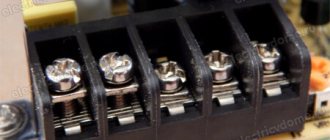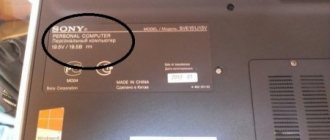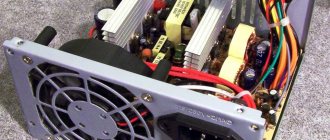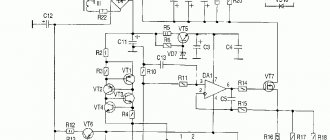DC power supplies, the circuit of which includes a rectifier (AC/DC converter), are popular devices widely used in automated test systems designed to test electrical equipment, modules, and wiring diagrams. They are also used to power various electronic equipment, electric motors, charge batteries, and carry out electrochemical processes. They convert AC mains voltage into stabilized DC voltage. Many models provide the ability to adjust output parameters.
A separate type of power supply (PS) is made up of converters (DC/DC converters). They operate on DC power. Their scope of application includes automated process control systems, energy, transport, telecommunications and information technologies, security and fire systems.
The main technical characteristics of DC power supplies are:
- Nominal input voltage.
- Rated output voltage and its adjustment range.
- Maximum load current.
- Accuracy of output voltage stabilization.
- Efficiency
In addition to the basic characteristics, other operating parameters are also of great importance, which we will consider in more detail.
Noises and pulsations
This characteristic of DC power supplies determines the quality of the output signal, as well as the choice between switching and linear power supplies. Switching converters are essentially noise generators. Devices that use pulse-width modulation to control the switching of power switches create noise in a certain frequency band. The noise repetition rate depends on the switching frequency of the switching power supply, and the amplitude is highly dependent on the equipment topology. Ripple is a fluctuation in the output voltage that is associated with the charging and discharging of the device. It can be reduced by increasing the input or output capacitance.
For many tasks related to testing electrical equipment, it is advisable to use linear rather than pulsed power supplies. Despite the fact that they are characterized by low efficiency, size and weight, and the generation of a significant amount of heat, they can be used in applications where high power is not required (up to 200 W per channel). Linear devices generate high-frequency noise that can be easily filtered out. They also have a high response rate to load changes. If the task at hand does not impose increased requirements on the level of noise and pulsation, it is better to choose a pulse converter. It is characterized by high power, compactness, wide adjustment ranges, and flexibility of settings.
Advantages and disadvantages of pulsed and linear light sources
Linear solutions are cheap and simple. This is the most attractive aspect of this technology. Therefore, lighting manufacturers are very enthusiastic about using LED linear drivers in their products whenever possible. In general, LED linear drivers can be an excellent solution for lighting systems where light quality is not a top priority and the cost of lighting products is a major concern.
The absence of electromagnetic radiation is one of the important technical advantages of linear LED drivers. This feature solves problems encountered in the fields of medical, aviation and automotive lighting, where the requirements are very high.
Linear LED drivers are inherently more reliable than LED drivers that use electrolytic capacitors to absorb voltage surges that may be present on the AC line. Electrolytic capacitors are prone to premature failure at high ambient temperatures, reducing circuit reliability. LED linear drivers do not use this energy storage device, instead they use solid state driver ICs to regulate the load.
Most linear LED drivers work with legacy triac dimmers without the use of additional dimming circuitry. These drivers do not contain reactive components such as coils and capacitors, which create a reactive load on the resistive dimmer and thus cause incompatibility.
Design issues
Despite all the benefits that come with driving LEDs using linear regulators, the design of a linear LED driver or light engine involves many trade-offs. The beauty of this technology lies in its simplicity. When more features are required, higher quality lighting is required, or strict adherence to codes is mandatory, line driver technology loses its luster. The benefits of linear LED drivers come at the cost of many sacrifices.
Electrical safety
In switching power supplies, a high frequency transformer can be installed with a primary and secondary winding to block dangerously high voltages. On the other hand, linear LED drivers have a high voltage breakdown path through the control circuit. An LED lamp whose power is controlled by a linear LED driver is dependent on the insulating properties of its housing, which is a serious safety issue.
Efficiency and heat dissipation
Operating an LED array with linear LED drivers means that there is always a voltage drop. A large voltage drop not only means low efficiency, but also an increased thermal load on the lighting system as excess electrical power is dissipated as heat. As a result, an LED lighting system operating in this mode entails additional thermal capacity to receive heat flow from the driver circuit.
Flicker
In a linear regulation circuit, the load applied to the LEDs is essentially the intermediate DC voltage that would be present in an LED lighting system. A residual AC waveform may appear in the output as variations or ripples. Residual ripple after the rectifier-filter cascade causes flicker, which significantly degrades the quality of light.
Strength Factor
To smooth out strong current ripples, a large capacitor can be used on the primary side. However, this can reduce power factor requirements because the reactive power consumed by the energy storage device distorts the waveform of the primary side rectified current. Power factor can also be affected by non-resistive dimming. LED lamps rated greater than 5 W must have a minimum power factor of 0.7, and all LED power supplies greater than 25 W must have a power factor greater than 0.9. Often, luminaire designers must make difficult choices between flicker control and compliance.
Output voltage change rate
This is an important parameter that is of great importance in the field of testing electrical appliances. During testing, different voltages are applied to the equipment to verify that it is functioning correctly within its operating range. The faster the power supply responds to changes in settings, the higher the testing performance. In standard devices, the time to set the output voltage with an accuracy of 1% is on average 50-500 ms. There are special circuits for regulated DC power supplies that can reduce this figure to 1-4 ms.
Response time to load changes
This parameter determines how quickly the power supply reacts to load changes or power surges. If the output current changes rapidly over a wide range of values, the output voltage also begins to decrease or increase at a high rate. The time it takes for a device to stabilize its characteristics is called reaction time to a change in load. Due to the use of feedback in the topology to control the output voltage, switching power supplies are characterized by a relatively slow response.
To protect the devices under test from severe overloads, it is recommended to use a preload. It is connected in parallel with the device under test and limits voltage surges. Modern switching power supplies have a response time of 40-80 µs, and linear ones - up to 1 µs.
VARIETIES OF DEVICES
Main types of power supplies:
- linear;
- pulsed.
The devices of the first type certainly include a transformer that converts the original voltage to a lower one, and a rectifier that converts alternating current of standard frequency (in Russia - about 50 hertz) into direct current, required for the operation of household or industrial equipment.
Additional components are a filter designed to level out voltage surges and dips, a stabilizer, a high-frequency filter and short-circuit protection.
All these components make it possible to obtain a perfectly smooth signal at the output, which is especially important for sensitive electrical devices: the “purer” the current supplied to them, the longer they can last.
Advantages of linear devices:
- ease of installation and repair;
- increased reliability;
- minimal, up to zero, percentage of interference and fluctuations in the output signal;
- accessibility - transformer devices are relatively inexpensive.
Disadvantages of linear converters:
- dimensions - they take up at least twice as much space as pulse ones;
- massiveness - the characteristics of the components used do not allow transformer blocks to be made light;
- low efficiency - energy losses in the network with a connected device are at least 15%.
In switching or inverter power supplies, more complex transformations occur: first, alternating current is converted into direct current, and then high-frequency pulses are generated, supplied through a small-sized high-frequency transformer to a rectifier and high-pass filter, then the output.
Thus, the devices guarantee higher quality alternating current with the absence of unacceptable differences, and its conversion to direct current is carried out in the “receiving” devices.
The main elements of pulse devices are:
- small-sized primary converters of alternating voltage to direct voltage;
- stabilizers operating on the principle of negative feedback and guaranteeing a “flat” resulting signal;
- low-frequency filters to ensure the absence of noise at the output.
Additional components include alternate or redundant filters, short-circuit and no-load protection, and AC-to-DC output transformers.
Advantages of pulse devices:
- small dimensions - such devices are at least two times smaller than linear ones;
- light weight - inverter units weigh relatively little;
- high efficiency - losses when connecting equipment to the network are in the range of 2...10%.
Disadvantages of pulse devices:
- complexity of the device and repair;
- higher cost compared to linear units;
- high-frequency interference that negatively affects the operation of sensitive devices.
Currently, both linear and pulsed equipment are equipped with stabilizers, which make it possible to obtain a smooth signal at the output, without sudden jumps. A stabilized power supply extends the life of household and industrial equipment, and also, even without the use of additional protection, reduces the risk of a short circuit in the network.
Such devices should not be confused with household voltage stabilizers of 220 Volts.
Possibility of parallel and serial connection of IP
Parallel connection of power supplies increases the output current. Many power supplies are equipped with a specialized parallel control bus. It allows you to create a single configuration from multiple sources. The system automatically determines which devices are master and which are slave.
Series connection of power supplies is used if increased voltage is required. However, it should not exceed the electrical insulation strength of the output terminals.
Modern power supplies
Various electronic devices have long been firmly established in our lives. Devices of the widest range of applications and degrees of complexity take our lives to a completely new level of comfort and possibilities. However, in order for any equipment to function, it must have access to electrical power. This requires power supplies - devices responsible for supplying power.
Moreover, almost all types of power supplies are responsible for performing three main functions:
- electricity conversion
- stabilization
- adjustments.
Types of power sources
All power sources can be divided into two groups: primary and secondary.
- Primary ones are engaged in converting various types of energy into electrical energy. For example, there are batteries that convert chemical energy into electricity.
- Secondaries are not responsible for generating electricity. They only deal with changing its characteristics necessary for specific equipment. In particular, the indicators of current, voltage, voltage ripple, etc. change.
Among the various types of power supplies belonging to the secondary category, power supplies are especially in demand.
What are the types of power supplies?
Power supplies (or secondary power supplies) are devices that provide electrical appliances with the electrical energy they need by converting energy received from other sources. In this case, the energy must correspond to a number of parameters, such as current, voltage, etc.
Power supplies can be:
- built into the overall scheme
- used as a module
- be located in a separate room.
There are two main types of power supply designs: pulsed and transformer, also known as network ones.
The advantage of switching power supplies is reliability, the presence of protection circuits against force majeure situations, a wide range of frequency and supply voltage, lower cost than network models, high efficiency and lighter weight.
The advantages of network power supplies are considered to be an accessible base of elements, simplicity of design, absence of radio interference, unlike pulse models, and reliability.
Among the types of power supplies, uninterruptible power supplies deserve special attention; they are extremely popular in both the industrial and domestic spheres.
Features of uninterruptible power supplies
Uninterruptible power supplies, also known as UPS, are an electronic automatic device equipped with a battery. UPSs provide uninterrupted power supply to the computer and its components for a short period of time.
A UPS is necessary so that in the event of a sudden drop or interruption of the input supply voltage, it is possible to save the necessary data and shut down the PC correctly.
It should be remembered that uninterruptible power supplies are not suitable for a constant or even long-term supply of electricity to a computer. UPS, also known as UPS (Uninterruptible Power Supply), are only auxiliary equipment. In order to provide the PC with long-term power supply, you can use devices like generators or backup power supplies (RPS).
What types of UPS are there?
Among the variety of UPSs on the market, only three types of devices are truly types of uninterruptible power supplies:
- UPS Line-Interactive
- UPS On-Line
- UPS Off-Line.
All other similar devices are in fact only their derivatives.
Summing up
Power sources have long become an essential part of our lives. They are in demand both in the industrial and household spheres, since most of the devices used by humans run on electricity. Of course, power supplies, as well as uninterruptible power supplies, are one of the most important inventions in the history of mankind; they solve many problems related to the supply of electricity.
Digital programming
Many power supplies support digital programmability for constant voltage (CV) or constant current (CC) modes. The devices operate in voltage stabilization mode provided that the load current is less than the set value. After the electric current reaches a threshold value, the IP switches to current stabilization mode. The output voltage can be limited to prevent power overload. Configuration is carried out through the device control panel or from a computer via USB, LAN, GPIB interfaces.
Programming provides advanced control capabilities. For example, you can sequence changes in voltage and current, generate sawtooth and other signals for testing fuses and various electrical appliances.











